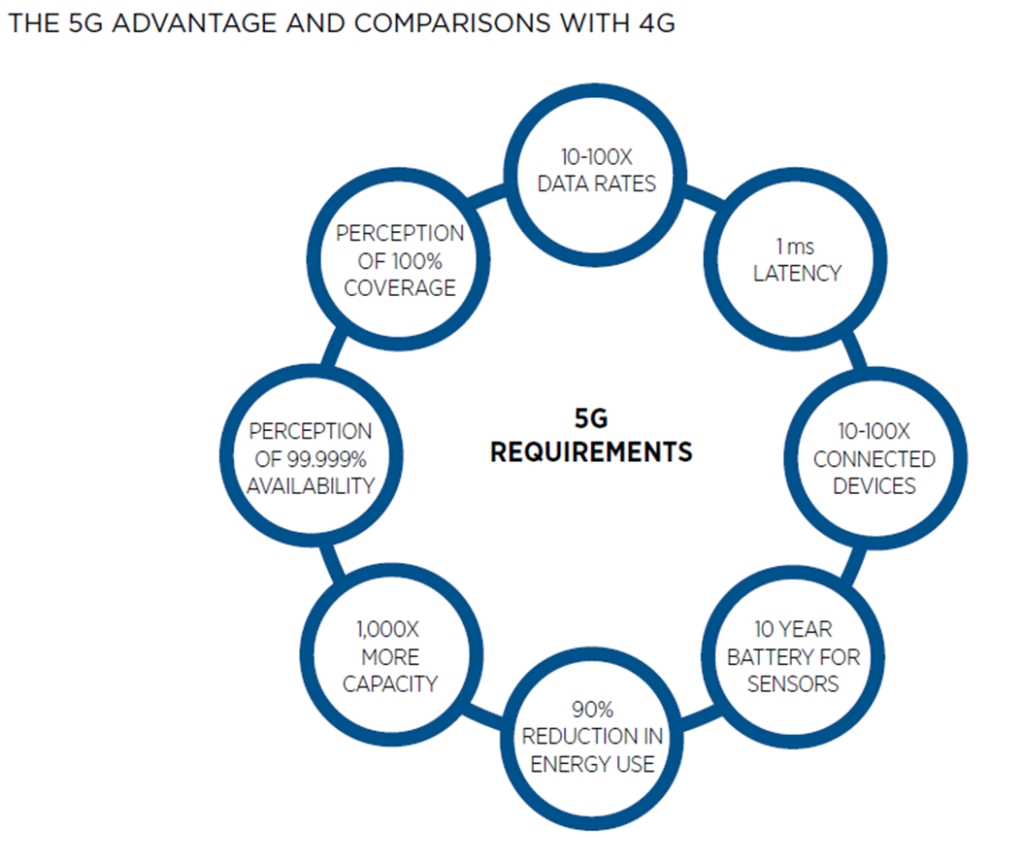5G: The Hype, the Hope and the Must Have?
 By: Ron Chebra, VP of Grid Modernization
By: Ron Chebra, VP of Grid Modernization
rchebra@enernex.com
865-218-4600 x8108
Cellular carriers have invested significant marketing dollars in promoting their 5G cellular services, touting lightning speeds, universal access and amazing streaming video services that this next generation of connectivity will provide. In their effort to entice customers to jump to their network there has been a proliferation of future capabilities that have set expectations that may take some time to realize.
What is all the hype about 5G?
There are many advancements that are at the core of 5G that indeed can provide increased speed performance over earlier generations, the International Mobile Telecommunications 2020 standard (IMT-2020) identified 8 fundamental requirements improvements over 4G, as shown in the following chart:

To achieve these, a “Family” of 5G services have been identified, namely, Enhanced Mobile Broadband (eMBB); Utra-Reliable and Low Latency (URLLC) and Massive Machine-type Communications (mMTC). Each of these legs of the offering triangle have their respective targets, including All Data, all the time; mission critical applications and billions of “internet connected” devices.
While the 5G family covers the gamut of these, carriers are deploying their infrastructure where they foresee the largest customer need and greatest revenue potential. This may or may not align with the needs that utilities have today for monitoring and control.
What is the hope of 5G through the eyes of a utility?
Based on a recent study commissioned by DSTAR on this technology there is great potential that wireless communications can unlock. There is a growing need for more sensors to monitor the conditions of the distribution networks, be the electric, gas or water. Data that is captured on current state of conditions is being used for growing analysis and analytics to better manage, inform and provide situational awareness. Increased use of edge computing is pushing intelligence at the point of control, with the need to have timely upstream and downstream insights that is blend distributed intelligence with common control.
Sensors and computing are becoming commoditized; robust, secure and reliable communications networks are becoming more prolific and standardized, and the science of data use, interpretation and management is becoming a dominant force.
While the urgency for high capacity pipes that can support transportation of Gbits may not be acute in the utility space, sensor networks and wireless SCADA are clear targets of need. In particular, as more and more distributed energy resources are interconnected and integrated into the distribution systems, intelligent controllers will need to be orchestrated by the utility. Just as the IT environment has migrated from mainframes (central power plants) to laptops (DER) enabled by information internetworking, so too will network communications with non-centrally located asset be required.
The hope is that standardization and long-term availability and suitability of these communications networks will outlive the field sensors and back office systems.
Will 5G be the must have of the utility industry?
The need for secure field communications networks will increase as the geographic diversity of assets increases. Whether utilities subscribe to common carrier services to provide these pathways or if owned assets such as licensed spectrum, which a number of utilities own or are purchasing, are the means by which connectivity is achieved; the need for digital wireless field area networks are on the must have list.
The foundational tools that carriers are deploying for their commercial offerings are being tailored to meet the network slicing requirements for utility applications and are also being leveraged to be the core platforms that utilities are using to deploy their own Private Long Term Evolution (P-LTE) infrastructures.
The future outlook for digital wireless communications is strong and holds great potential to achieve the balance of awareness and control required to sustain the energy needs in this changing world.
Closing thoughts:
- 5G networks will eventually fulfil the hype of services that the carriers are promising, but the timing and direction with which they pursue deployment may not be directly influenced by the needs of the utility.
- Robust, secure and prolific wireless networks will grow as more distributed assets are deployed.
- Utilities may be reluctant to rely exclusively on carriers for essential and mission-critical services; private wireless networks will be deployed as owned assets when economic and service requirements make prudent investments.
About the Author
Ron Chebra, Vice President of Grid Modernization with EnerNex, is a recognized thought leader and industry expert in utility modernization. He has deep operating knowledge of technology solutions in areas such as microgrids, battery energy storage, renewable energy integration, smart grid, distribution automation, advanced metering infrastructure, demand response and “Behind the Meter” technologies. He provides strategic consulting services to leading energy organizations and to industry suppliers of products and services. Ron is a frequent contributor to leading industry journals and has previously been the Chairman of the Smart Cities/IoT Track for DistribuTECH. Ron has over 35 years of experience, including previous positions with Verizon Enterprise Solutions, Schneider Electric and DNV GL.


